INTRODUCTION
Hemp (Cannabis sativa L.) is an annual herbaceous plant belonging to the family Cannabinaceae(Turner et al., 1979), traditionally grown for fiber and seed production. Whole hemp seed contains approximately 25% crude protein, 33 to 35% oil, and 34% carbohydrate, in addition to a broad range of vitamins and minerals (Darshan and Rudolph, 2000; Callaway, 2004; House et al., 2010). Hemp seed oil contains 75 to 80% polyunsaturated fatty acids (PUFA), including 60% linoleic acid and 17 to 19% α-linolenic acid (ALA) (Parker et al., 2003). The nutrient composition of hemp products provides evidence that these products may serve as potentially valuable livestock feed ingredients.
In the past, the cultivation of hemp was prohibited due to the high content of Δ-9 tetrahydrocannabinol, a psychoactive substance present in the hemp plant. In the recent decades, regulatory changes undertaken by several countries across the globe allowed for the legal cultivation of industry hemp under a license that permits plants and plant parts of the genera Cannabis, the leaves and flowering heads of which do not contain more than 0.3% Δ-9 tetrahydrocannabinol (wt/wt), and includes the derivatives of such plants and plant parts (Health Canada, 2012; Jing et al., 2017). The nutritional profile, in addition to the increase in production and availability of hemp and hemp products create opportunities to use them in livestock diets (Gakhar et al., 2012). Significant research across the globe that has gone into evaluating the safety of the ingredient showed that including hemp in animal feed is safe and offers benefits for improved animal performance and human health (Gakhar et al., 2012; Jing et al., 2017). Hemp and hemp products in layers not only contribute protein but also they can be valuable sources of essential fatty acids such as linoleic acid to improve egg weight (March and MacMillan, 1990; Parker et al., 2003; Silversides and LeFrancois, 2005) and linolenic acid, an omega 3 fatty acids, which have proven to have beneficial effects on human health (Erasmus, 1993; Lewis et al., 2000).
It has been demonstrated that the addition of ingredients contributing fatty acids in the feed contribute with the fatty acid deposition in animal tissues such as meat and eggs (Gonzalez-Esquerra and Leeson, 2001; Ribeiro et al., 2014; Jing et al., 2017). This can be considered a significant accomplishment for fulfilling current recommendations of increasing n-3 fatty acid intakes, particularly in most western countries where the recommended daily intake of these compounds is rarely met (Kris-Etherton et al., 2000, 2003).
The polyunsaturated fatty acids (PUFA) composition of cell membranes is to a great extent dependent on the dietary intake (Simopoulos, 2002). When people ingest EPA and DHA from the diet, they partially replace the omega-6 fatty acids, especially arachidonic acid, in the membranes of probably all cells, but especially in the membranes of platelets, erythrocytes, neutrophils, monocytes and liver cells (Simopoulos, 1994). Very high level of omega-6 similar to the food in Western hemisphere diets (Weber, 1989; Weber and Leaf, 1991), products such as prostaglandins, thromboxanes, leukotrienes, hydroxy fatty acids and lipoxins are formed in large quantities which may contribute to the formation of thrombus, and atheroma, to allergy and inflammatory disorders (Simopoulos, 2002). Since a diet high in omega 6 shift the physiological state to one that is prothrombotic, there is an increase in blood viscosity, vasospasm, and vasoconstriction and decreases in bleeding time. Hemp has shown in previous studies to reduce the omega 6/omega 3 fatty acid ratios which contribute to enhanced human health (Simopoulos, 1994).
Hemp products are also shown to be excellent sources of yolk pigmentation, lutein and fatty acid enrichment of eggs. Genetic improvements to limit Δ-9 tetrahydrocannabinol to less than 0.3% (w/w) in hemp leaves and flowering heads of the genera Cannabis, have made them safer as a feed ingredient. The use of hemp seed cake (HSC) has not been approved in diets for any class of livestock in the USA due to a lack of research in support of its safety and efficacy (Malone and Gomez, 2018). The current study is designed to determine the effects of feeding HSC on the fatty acids profile and cannabinoid residues in tissues and products of laying hens.
MATERIALS AND METHODS
Experimental design
The study was conducted at a commercial layer farm in Lancaster County, with coordinates 40°05’51.37” N 76°33’29.75” W elev 365 ft, eye alt 3920 ft PA. Eight hundred Bovans white caged hens lay at 30-weeks of age, were distributed into 4 treatments that consists of 200 hens per treatment based on inclusion levels of HSC. The control diet (C0)– regular diet with no HSC, (H10)- basal diet with 10% HSC, (H20)- control diet with 20% HSC, (H30)-control diet with 30% HSC. Each treatment comprised of 8 cages of 25 hens each per replicate. Observations per protocol were made over a timeline of 19 weeks.
Acclimation of test animals
In order to eliminate the impact of the new ingredient and its differential inclusion levels, the hens under study were subjected to a period of acclimatization for 3 weeks when the respective treatments were fed with the study diets allowing for acclimatization of feed consumption and gut environment. Observations and data from the period of acclimation were not considered for the purpose of this study.
Environment and management
All the hens under study were subjected to the following environmental and management uniformly. Special feed troughs were designed to bypass the existing auto-feeders and the hens were fed manually once a day. An iso-caloric, iso-nitrogenous diet with nutrient levels set at 25lb/100 hens/day consumption as per breed standard was designed across all treatments. Continuous water, identical environment and management were offered uniformly across treatments. Hens were weighed on cage basis prior to start of the experiment and composition of hens per cage was managed for uniformity of body weight across treatments. Environmental conditions were maintained at 23.33- 24.44°C house temperature, 40-60% humidity, 30 Lux lighting for 15 - 16 h of lighting per day and air movement between 2550 and 3400 m3/h per 1000 hens. The general performance data of hens under study were compared from time to time with rest of the commercial layer house to ensure no unexpected or significant differences were noticed.
Inclusion and exclusion criteria
In order to establish uniformity of population across treatments, the cages were individually weighed for initial weights and, hens moved between cages so as to maintain a total body weight difference not exceeding 2.5%. These weight-adjusted cages were then randomized within the 32 cage locations with 2 cages of same treatment together. A plastic plate was installed between each cage thus preventing hens from picking feed from adjacent cage feeder. Ailing and visually sick hens were weighed, euthanized, necropsied and disposed of per farm disposal policy; culled hens from the study were not replaced. However, necessary feed adjustments were made whenever culling was required. Medication required was applied across treatment to maintain uniformity and consistency.
Nutritional composition of HSC and finished feed
The analysis of the nutritional composition of HSC and the study feeds formulated with HSC are presented in Table 1 and the formulation of the feed is presented in Table 2.
Feeding program
Study hens were offered a uniform free-choice restricted amount of feed at 25lb/100 per day. At this level, it was expected that the hens consumed nutrients per breed recommendation for the age and stage of production Bovan Management and commercial Product Guide (2019).. The feed intake was kept constant across all treatments. A pre-weighed 6.25lb of feed was provided to each cage of 25 hens every day at the same time.
Study parameters, test and analytical methods
Fatty acid profile
Eggs: Three samples from each treatment was selected and the mean fatty acid values were expressed as percentage of egg weight (Cherian et al., 2007; Jing et al., 2017) along with linoleic to linolenic acid ratio. The fatty acid composition was determined using standard gas chromatographic techniques of the fatty acid methyl esters (AOAC, 1990, method 969.33), with C17:1 fatty acid (Nu-Chek Prep, Inc., Elysian, MN) used as an internal standard. Total lipids were extracted from the test diets, egg yolks, breasts, and abdominal fat by homogenization in chloroform/methanol (2:1, v/v) according to the methods of Folch et al. (1957). After centrifugation, the organic phase was collected and evaporated under a nitrogen stream. The lipid extracts obtained were trans-esterified with methanolysis (1% (v/v) sulfuric acid in methanol for 3 h at 70°C. After cooling, the resulting fatty acid methyl esters (FAMEs) were extracted with hexane and transferred into gas chromatography (GC) vials. All solvents contained 0.005% (v/v) butylated hydroxyanisole (BHA) as an antioxidant. FAMEs were then separated and quantified with a Varian450-GC with CP-8400 autosampler, equipped with a flame ionization detector and a GC column (length 30 m, inner diameter 0.25 mm and film thickness 0.25 μm, DB-225MS) (Agilent Technologies, Mississauga, ON, Canada). Nitrogen was the carrier gas at a column flow rate of 1 ml/min. The inlet split ratio was set at 10:1. The oven temperature programming was as follows: 60°C for 1.5 min, raised to 180°C at 20°C per minute, 205°C at 6°C/min, 220°C at 2°C/min for 4 min, and 240°C at 10°C/min for 3 min. The injector and detector temperature were set at 260 and 290°C, respectively. FAMEs were identified by comparison of retention times to known lipid standards (Nu-Chek Prep, Inc., Elysian, MN) (Folch et al., 1957; Jing et al., 2017)
Breast meat and abdominal fat (%): The fatty acid profile of breast meat and abdominal fat was analyzed using the fatty acid procedure of Eurofins Laboratory, Madison, WI, Eurofins, as published by Folch et al. (1957) and Jing et al. (2017). A procedure similar to composite sample for egg quality parameters was followed for preparing samples of right breast meat and right abdominal fat of study hens, as follows: collect samples from 3 hens from 8 cages per treatment for a total of 24 breast or fat samples. Prepare 3 replicates of 8 samples each with 1 sample from each of the cages, mix the 8 samples from each cage, homogenize for a minute, pack in a sterile plastic bag previously identified with details of treatment. This makes 1 composite sample. Prepare 3 such composite replicates per treatment. Repeat the procedure for other treatments.
Hemp cannabinoid residues
Eggs
Using whole egg composite sampling as described earlier, 3 replicate samples per treatment were submitted for hemp cannabinoid analysis of the eggs. Ice packed and preserved samples of organs and tissues were shipped overnight for the analysis of the residues of various hemp cannabinoids to Eurofins Laboratory, Madison, WI, method 2018.11, (AOAC, 1990) International (Modified by Lukas et al., 2018).
Blood
3 ml of blood were pooled from the wing vein and transferred to a heparinized coated tube from a hen per cage or 8 hens per treatment; the samples were stored for 24 h in a freezer at -4°C and the following day, they were shipped in dry ice pack to Eurofins laboratory (Madison, WI 53704 USA) for the analysis of hemp cannabinoids residues at weeks 8 and 16; the analysis was performed 7 days post collection. The whole blood samples were processed under refrigeration temperatures and shipped to Eurofins Laboratory for analysis of hemp cannabinoid residues.
Breast meat and abdominal fat
The hemp cannabinoid residue profiles of breast meat and abdominal fat were determined by collecting a portion of the right breast meat and abdominal fat samples at the end of the study (week 16) from 1 hen per replicate or 8 hens per treatment; the composite paste of the breast and the body fat samples were mixed and equally distributed into 3 composite samples (n=3) as replicates per treatment for statistical analysis. The composite breast meat and abdominal fat samples were put in plastic bags previously identified with the corresponding color-coded treatment identification; then samples were shipped to Eurofins Laboratory, Madison, WI, USA for analysis.
Table 1. Hemp seed cake and Feed nutritional analysis (%).
Table 2. Study diets formulated by treatment (lb).
Liver, kidney and spleen
The hemp cannabinoid residue profile in liver, kidney and spleen was determined at week 16 by collecting 1 cm segment of liver, kidney and the entire spleen. A composite sample procedure was followed. Collect samples from one hen per cage (8 birds per treatment) - a total of 32 samples. Prepare 3 composite samples per treatment with sub-samples from each of the 8 cages per treatment. Repeat the procedure for other treatments. The composite organ samples were put in plastic bags previously identified with the corresponding color-coded treatment identification; samples were then shipped to Eurofins Laboratory, Madison, WI, USA for analysis.
Statistical analysis
The hen body weight, fatty acid values from abdominal fat, breast meat and eggs were analyzed as a completely randomized design with cage as the experimental unit using the General Linear Model Procedure (PROC GLM) of SAS (SAS, 2012). The significant treatment mean separation was carried out with the Tukey Multiple Range test with a probability of error of 5% (P< 0.05).
RESULTS AND DISCUSSION
The analysis of nutritional composition of HSC and feeds formulated with HSC are presented in Table 1. In general, the nutritional composition results were within the expected levels and in agreement with the results in available published literature (Silverside and Lefrancois, 2005; Halle and Schone, 2013; Mierliță, 2019). The omega 6/omega 3 ratios in feed were reduced with the increase of the HSC levels. The 18:2 W6 (Omega 6)/18:3 W3 (omega 3) in feed was reduced from 20.79 in the control treatment to 9.08 in the H10, 7.47 in the H20 and 6.86 in the H30 (Table 1). The hemp cannabinoid residue levels of finished feed (Table 3) were reported to be below the laboratory detectable levels and under the legal limits of 0.3% across all treatments.
A general trend of reduced overall body weight across all treatments including control was noticed during the study. Feeding HSC to laying hens showed improved mean weekly body weights compared to the control treatment (Table 4) that was statistically significant at higher levels of inclusion. The trend in general showed no difference between control and 10% inclusion level, however, presented a positive trend at 20 and 30% across most part of the study. The mean of weekly mean body weights at the end of the study were higher at the 20 and 30% HSC fed hens over the control; however the difference was not statistically significant between 0 and 10% and between 20 and 30% (Table 4).
The results of mean fatty acid profiles of eggs presented in Table 5 showed evidence of significant influence of feeding HSC in total fatty acids which was significantly (P< 0.05) increased from 9.18% in the control to 9.97% in the H20; no significant effect was observed for total fatty acid in the H10 and H30 treatments. The supplementation of HSC increased (P< 0.05) the recorded levels of omega 3 and 6 in eggs with each increment level of HSC supplemented in the feed. The levels of omega 6 were increased from 1.45% in the control to 2.18, 2.61 and 2.94% in the H10, H20 and H30, respectively (Table 5). There was a decline in the level of omega-9 which was reduced from 3.53% in the control to 3.18, 3.06 and 2.77% in the H10, H20 and H30, respectively. The Polyunsaturated fatty acid (PUFA), Linoleic acid (LA) and alpha-linolenic acid (ALA) levels in the eggs significantly increased over control with increasing levels of HSC supplementation (Table 5). A significant corresponding reduction in LA:ALA ratio in eggs was noticed with greater inclusion levels of HSC. The LA:ALA ratios were reduced from 45.56 in the control to 18.86, 15.99 and 13.48 in the H10, H20 and H30, respectively (Table 5). The levels of monounsaturated fatty acids (MUFA) showed a significant reduction over the control with increasing levels of HSC except at 10% which showed only a numerical reduction. The total cis-fatty acid levels of all HSC fed groups were significantly higher over control showed an increasing trend with HSC inclusion which was statistically significant except between 20 and 30%.The breast meat fatty acid profile determined at the end of the study showed no significant difference (P> 0.05) due to supplementation of HSC in the diet of laying hens (Table 6); however, the levels of fatty acids in the abdominal fat determined at the end of the study (Table 7) shows that there were no significant differences (P> 0.05) in the total fatty acid profile of abdominal fat across the treatments, however, there was a clear trend of increased poly-unsaturated fatty acids (PUFA), Omega 3 and 6 fatty acids and decrease of Omega 9 fatty acids, with the increasing levels of HSC noted, though an inconsistent statistical significance was observed. The levels of total cis-unsaturated fatty acid levels differed significantly between the HSC fed treatment with control, however the same between HSC fed treatments were not significant. The mono-unsaturated fatty acid levels were significantly reduced in all HSC treatments compared to control and the differences between treatments were significant (P< 0.05) except between 20% and 30% HSC inclusion.
The mean cannabinoid residue levels, including delta-9-tetrahydrocannabidiol were below laboratory detectable levels of 0.0025% for egg samples (Table 8). The cannabinoid and related component levels of eggs in HSC treated treatments were not different from those of control tested at both intervals of the study (Table 8). The values for all cannabinoid and related compounds in the eggs were below the laboratory detectable levels regardless of the level of inclusion of HSC (Table 8) and in the control.
Table 3. Hemp cannabinoid residues of finished diets (< %).
Table 4. Mean body weight of hens (lb/hen)
Supplementation of HSC did not significantly affect the blood cannabinoid and related component profiles of hens during the study (Table 9). The levels of total hemp cannabinoids and individual components determined at the end of the study in breast meat were reported to be below the laboratory detectable levels (Table 10) in all experimental groups, including the control; similarly, the levels of total hemp cannabinoids and individual components determined at the end of the study in abdominal fat samples were found to be below the laboratory detectable levels (Table 11) in all experimental groups, including the control. An extensive assay of liver, kidney and spleen revealed the levels of cannabinoids and THC to be below the laboratory detectable levels in all experimental groups, including the control (Table 12).
Table 5. Fatty acids in eggs (%).
Table 6. Fatty acid profile of breast meat (%).
The nutritional profile of HSC makes this interesting as a potential feed ingredient in animals feeding; however, concern still remains due to the possibility of cannabinoid and THC residues in animal organs and tissues. Although HSC has not gained due attention in the USA, its nutritional properties and applications have long been recognized and valued as food for both humans and domesticated animals in China, India, Russia, Eastern Europe and Canada. There are not sufficient published references about the use of hemp seed cake on laying hens; most of the published literature on this subject and related areas is in other species and with using whole hemp seed or hemp oil or other hemp products. Given the extremely limited published research on the safety of feeding HSC in livestock the authors are constrained with few supporting references to quote on the findings. The authors have attempted to align with the closest possible references.
Table 7. Fatty acid profile of abdominal fat (%).
Table 8. Hemp cannabinoid residues in eggs (< %).
Table 9. Hemp cannabinoid residues in blood (< %).
Table 10. Hemp cannabinoid residues in in breast meat (< %).
The prime perceived nutritional value of HSC as an alternative animal feed ingredient is its superior fatty acid composition, with a high contribution of unsaturated and omega fatty acids. The importance and beneficial effects of unsaturated fatty acids and omega fatty acids are well established in both human and animal health (Jing et al., 2017). The general positive trend in total fatty acid levels, a strong Omega 3 and 6 fatty acid levels, polyunsaturated fatty acids (PUFA), linoleic and linolenic acid levels, cis-fatty acids and trends of reduction in saturated fatty acid levels, monounsaturated fatty acid (MUFA) levels, and linoleic (Omega-6): alpha-linolenic (Omega 3) ratios in egg and abdominal fat, only confirm the beneficial effects of feeding HSC. This reinforces the findings of Gakhar et al. (2012) using hemp seed and Silversides and Lefrancois (2005) using hemp seed meal.
Table 11. Hemp cannabinoid residues of abdominal fat (< %).
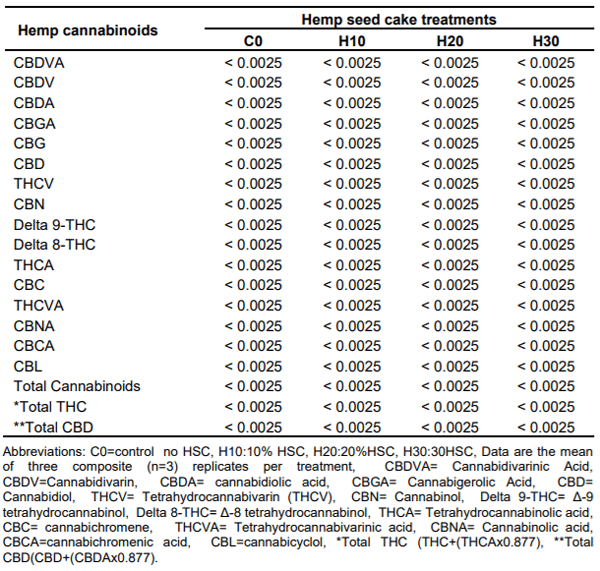
The high unsaturated fatty acid and essential fatty acid- Omega 3 and 6 - levels in eggs may be attributed to their high levels in HSC. This, together with reduction in Omega 9 and saturated fatty acids adds to enhancement of the nutritional profile of eggs. Omega-9 fatty acids (including oleic acid and erucic acid) unlike Omega-3 and 6 are not considered essential fatty acids. The LA (omega 6): ALA (omega 3) ratios in eggs were reduced from 45.56% in the control to 18.86, 15.99 and 13.48% in the H10, H20 and H30, respectively (Table 5). This reduction of the omega 6/omega 3 ratios is of upmost importance to reduce mortality from cardiovascular diseases. Simopoulos, (2002) reports that the omega 6/omega 3 ratio in Europe and United States is 50 with mortality from cardiovascular disease of 45% compared to the omega 6/omega 3 ratios of 12 and 1 in Japan and Greenland Eskimos with lower cardiovascular diseases related mortality of just 12% and 7%, respectively.
The primary concern with feeding HSC to laying hens is its transfer potential of hemp cannabinoid residues, mainly cannabidiol and delta-9-tetrahydrocannabinol. Published research states that a level of Δ-9 tetrahydrocannabinol (THC), a psychoactive substance in the hemp plant (Health Canada, 2012) below 0.3% is safe for animal feeding (Jing et al., 2017). The current study demonstrates no contribution or transfer of cannabinoid residues to eggs or body tissues as evidenced by laboratory analysis of HSC, finished feed, egg, blood, breast meat, abdominal fat, liver, kidneys, and spleen. The mean hemp cannabinoid component levels, (including cannabidiol and THC) were less than the laboratory detectable level of 0.005% across study treatments with no significant differences. The fact that the hemp cannabinoids were not detected in the blood, organs and tissues or egg after 16 weeks of HSC feeding sufficiently demonstrates its non-contributory and non transfer nature of such compounds at designed inclusion levels. This finding is an addition to the current knowledge pool of safely feeding HSC to laying hens. The authors have not been able to proper compare with other studies due to the shortage of published literatures about the use of HSC in laying hens. In summary, this study confirms a significant fatty acid enhancement of egg and abdominal fat by feeding HSC and it is safe to be fed, since there was no transfer of cannabinoids or THC.
Table 12. Hemp cannabinoid residues of liver, kidney and spleen (< %).
Conclusion
The current study has sufficiently evaluated and demonstrated the following conclusions: HSC feeding to commercial laying hens up to 30% of ration best enhance the deposition of unsaturated fatty acids in eggs and abdominal fat. HSC feeding to commercial laying hens up to 30% did not transfer psychoactive hemp cannabinoid residues in blood, eggs, body fat, breast meat, liver, kidneys, and spleen.
Recommendations
Based on the results and conclusions made from this study, HSC may be recommended in laying hens up to 30% to enhance the unsaturated fatty acid content in eggs, that may contribute to enhance human health.
CONFLICT OF INTERESTS
The authors have not declared any conflict of interest.

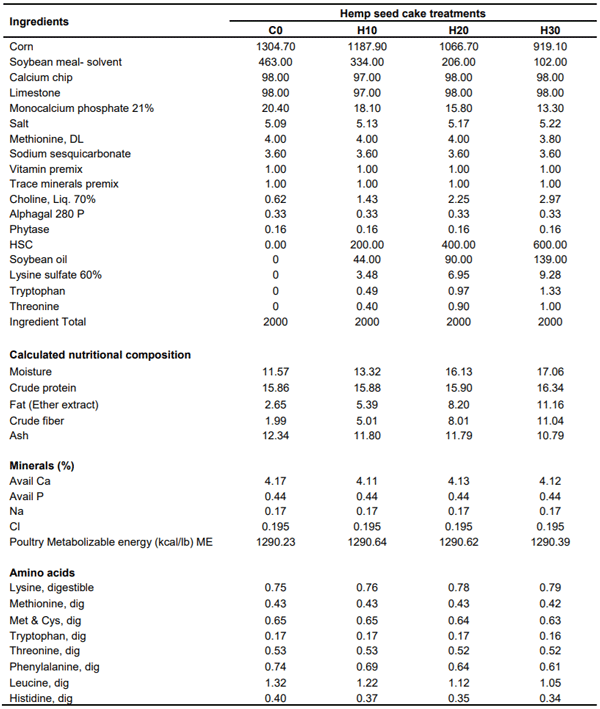
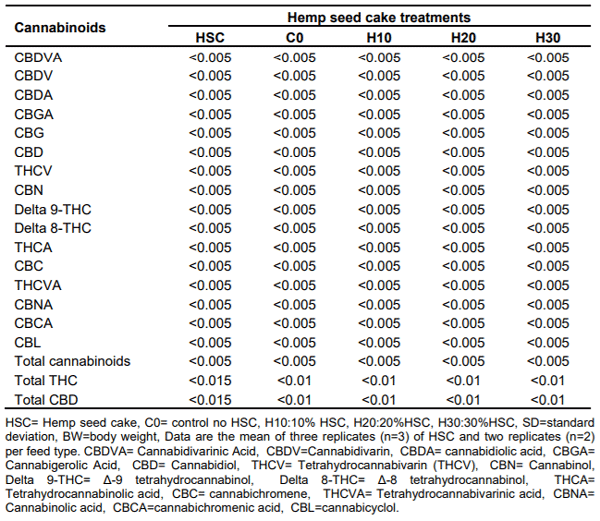
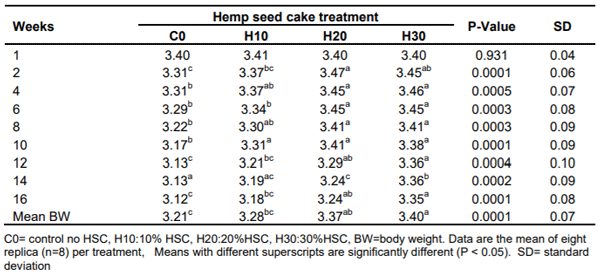


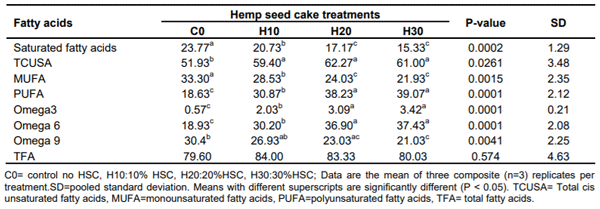

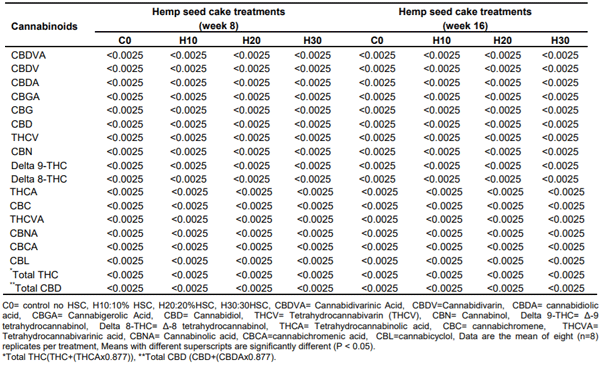
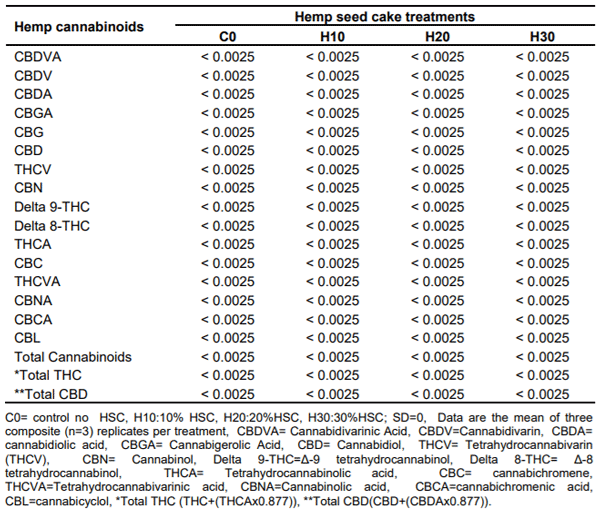

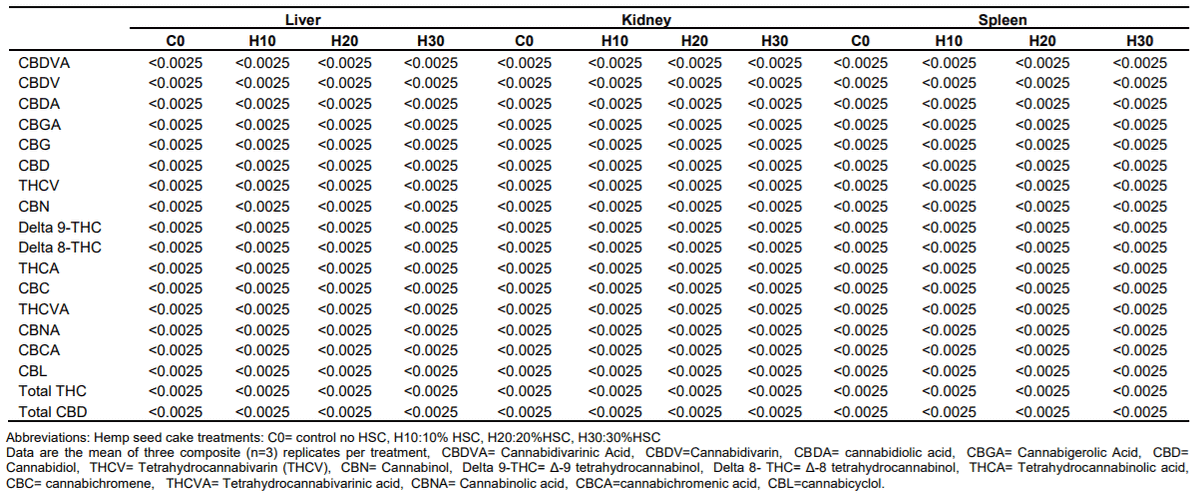









.jpg&w=3840&q=75)